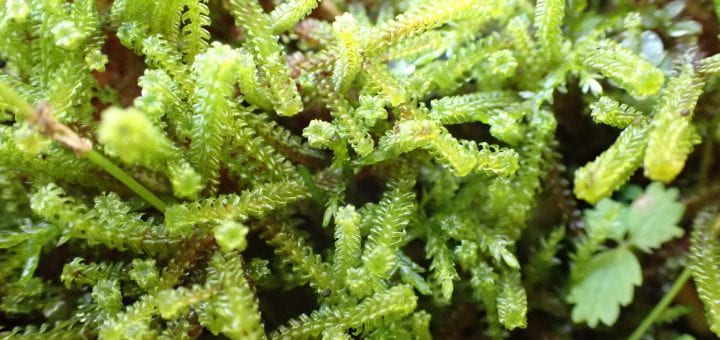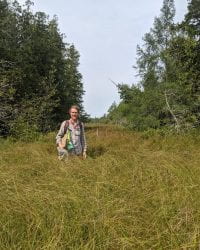
Prof. Keir Wefferling discovers moss previously unknown to Wisconsin
In the average lawn, moss is rarely a welcomed sight. (Usually indicating poor soil nutrient levels and drainage issues.) But in Keir Wefferling’s world, as curator of the Fewless Herbarium within UW-Green Bay’s Cofrin Center of Biodiversity, encountering moss is not only welcomed but occasionally transformational.
That was the case one morning this fall when he, along with a couple of eager volunteers, Joan Berkopec and Ron Eicchorn, trekking through a sedge meadow and fen in northeastern Wisconsin, happened upon Paludella squarrosa or “tufted fen moss”. To any passing hiker with an untrained eye—just another plant.

Keir Wefferling, Photo courtesy of Nate Schwartz
But this expedition’s mission was to perform a preliminary bryological (mossy things) survey of the region. And even to Wefferling’s well-trained eyes, this was a mossy thing he had never seen before.
“When I saw it, I didn’t know what it was. I knew it was a moss and I knew it was a moss I’d never seen before. It was just unique looking.”
Wefferling knows his plants. In fact, that’s why he’s here—starting in August 2020 as an assistant professor and Herbarium curator. Since then, an interest in moss has grown on him. “I started my studies with the flowering plants and then got into ferns. Only in the past year, while exploring Wisconsin, have I really begun to appreciate mosses. I would say moss is under-appreciated and not just in its usefulness to humans. They’re cool and valuable in their own right.”
What’s also underappreciated is the Fewless Herbarium’s wealth of about 45,000 painstakingly dried, cataloged plant specimens tucked away in the basement of Mary Ann Cofrin Hall next to the Richter Museum of Natural History (also part of the Cofrin Center for Biodiversity, housing animal specimens).
As Wefferling explains, much like the plants themselves, this is a museum that leads a quiet existence. “All the specimens are in cabinets. To look at a specific plant you go to that cabinet and pull out the folder, bring it to a table and open it up to look at that plant.”
But that doesn’t mean that the work going on, or the plants collected inside, aren’t important.
“The museum isn’t just to hold specimens, just to sit there. Herbarium specimens are actively used for research; borrowed and loaned to other herbaria, potentially all over the world. We ship specimens to other herbaria, and somebody may borrow them for one or two years.”
Internship opportunities also exist for graduate students in Environmental Science and Policy— a flourishing program with currently more than 30 students. And as for any undergraduate student who enjoys collecting and time spent with pressed plants, work-study opportunities are also available.
Plans are in the works to photograph, digitize and upload the collection to a free and open portal to make the collection more accessible. That information would help clarify the understanding of the geographic and ecological relationships of plants throughout the region. And that effort aligns with one of the University’s core strategic priorities to make a profoundly positive impact on the environment of our region.
As far as the impact of discovering Paludella squarrosa in Wisconsin? Wefferling will be presenting his findings at the Wisconsin Wetland Association meeting next February. Plus the exact location of the moss remains as closely held as a coveted morel mushroom patch.
And for those who ask the inevitable “so what?” Wefferling’s answer rings true to the mission of all universities—that making a fresh discovery, even of a humble moss, and creating new knowledge is always eventful.
“It’s never been found—at least not by botanists—in the State over all the years of exploration and scientific study. And it’s presumably been here the whole time. Of course it may be known by people of First Nations, and is therefore not a “discovery” so much as a “discovery to Western Science.” Whatever the case, the recorded knowledge of our regional flora is apparently—and excitingly—incomplete.”
Stay tuned for the next chapter in search of the lost moss.
